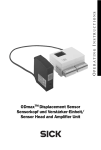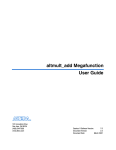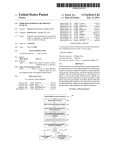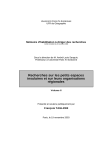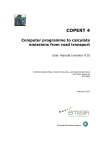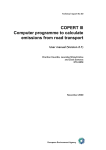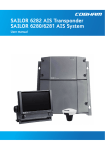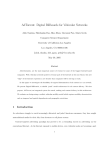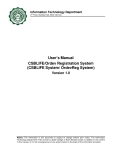Download Full Paper
Transcript
1 Extending E-Ticketing Service with Mobile Transactions Shirley Siu, Zhen Sheng Guo, Simon Fong and Sofia Zhuang Abstract— The emerging technology in mobile devices presents new business potential to Internet enterprises. These devices enable users to access the Internet at any time in any location. Based on the infrastructure of the existing e-commerce applications, these enterprises can extend their services to the vast population of mobile users by redesigning some of their business process. Taking the E-Ticket system as an example, this paper examines the requirements of m-commerce applications, and explores the benefits that mobility contributes by investigating how the electronic ticketing service can be extended to the mobile users. Index Terms—Design of mobile application, Mobile commerce, Electronic ticket, Pervasive computing. I. INTRODUCTION T HE emerging technology in mobile devices presents new business potential to Internet enterprises. These devices, equipped with Web-ready micro-browsers, enable users to access the Internet without needing a computer or wired connection. Customer access can be at any time in any location. This way of interaction between business and customer is the power of mobile commerce. To exploit the benefit of mobility, current e-commerce service should be extended to provide services target to the mobile users. Ticket booking from the web (or e-ticketing such as event or amusement ticket) is one of the widely available services in e-commerce. This phenomenon will continue in the arena of m-commerce as predicted in numerous studies: the Strategy Analytics report forecasting the future m-commerce market summarized that electronic ticketing will be one of the most successful m-commerce applications [1]. A survey conducted by Nokia Networks indicated that the most demanded service/product for m-commerce is likely to be movie and theatre tickets, closely followed by travel-related services and music [2]. Yet another empirical study in the Finnish population in 2001 shows that ticket booking is the third killer m-commerce application besides email and banking [3]. It is This work was supported in part by the Macao Secretary of Social Affairs and Culture and University of Macao Research Committee. Ms. Shirley Siu is with the Department of Computer and Information Science, University of Macao, P.O. Box 3001 Macao (telephone: 853-3974-476, e-mail: utakosiu@ umac.mo). Prof. Guo Zhen Sheng is with the Department of Computer and Information Science, University of Macao, P.O. Box 3001 Macao (telephone: 853-3974-463, e-mail: zsguo@ umac.mo). Dr. Simon Fong is with the Department of Electrical and Electronics Engineering,University of Macao, P.O. Box 3001 Macao (telephone: 853-3974-473, e-mail: ccfong@ umac.mo). Ms. Sofia Zhuang is with the Department of Computer and Information Science, University of Macau, P.O. Box 3001 Macao (telephone: 853-3974-473, e-mail: syz@ umac.mo). ICITA2002 ISBN: 1-86467-114-9 apparent from these researches that electronic ticketing is a demanding and welcome service by mobile users with no doubt. With the added mobility in customer’s end of the e-commerce chain, a full-blown ticketing service can be provided, which not only includes booking/purchase, view and deliver tickets but also advertise new events and help customers to locate seating area, etc. In this paper, we examine the requirements of m-commerce applications and explore the benefits that mobility contributes by investigating how the electronic ticketing service can be extended to the mobile users. II. COMMON TICKETING PROCESS IN E-COMMERCE From selection to ticket usage, it involves a couple of steps. See Fig. 1: Customer browses through a list of events to select the desired item. The purchase request is composed and sent after the ticket parameters are specified such as date, time and seating area. If payment was required, after both parties agreed the deal, the customer would be requested to pay by some suitable payment methods [4]. The transaction is confirmed and the result is stored in the server side. Then customer needs to get the issued ticket (e.g. paper ticket) from a physical location before using it, which may be the venue counter or ticket agent in somewhere else. The ticket must be presented and checked for validity at the service entrance point by a staff or machine. Finally, customer may receive guidance to seating area or obtain extra information about the venue. c d e f g h Select ticket Purchase ticket Can be completed online Pay Get ticket From venue counter, or ticket agent beforehand Examine ticket At entrance gate, automatically or manually Get seating direction, venue information From venue’s map or ask the staff (if necessary) Fig. 1. Common flow of ticketing in E-commerce. 2 The disadvantage is obvious. With current infrastructure, only step 1 to 3 can be completed securely online, while the remaining steps are done manually, or rather as in classical way. the service is available to everyone owning a compatible device. Most users dislike subscribed service that usually involves complex initialization procedure and must stick to the telecommunication company [7]. In recent years, there are approaches to replace the paper tickets with smart cards. (Ticket is then converted to data bits or electronic object, and download to the chip of the card through a card reader.) It has the notion of strong security that can prevent the creation of false tickets. Nonetheless, adoption of smart tickets usually involves some complex issuance procedure and increases the cost of operation. Smart card is more expensive as compared to paper ticket. To deliver ticket directly to the smart card at customer’s site, it may need pre-installation of software and hardware. Besides, ticket information cannot be read from the card without using a card reader. This actually causes inconvenience to customer using the ticket. After all, customers are still required to approach the venue counter or agent to obtain the card. IV. EXTEND E-TICKETING SERVICE TO M-COMMERCE III. REQUIREMENTS OF M-COMMERCE APPLICATION Mobile computing involves new parameters that are not considered in normal web-based system. They are the mobility of elements, limited screen size of portable devices, constraints in computational power and limited wireless bandwidth [5]. Hence, m-commerce applications should meet the following requirements: 1. Adaptive to wireless network environment. Unlike wired network, wireless network is inherently unreliable and unstable in terms of connectivity. Application with transactions must be carefully devised to avoid data inconsistency after an unexpected connection lost. 2. Scalable. The application is required to support wide variety of mobile devices which are being used in the market. It should not confine to a proprietary protocol, or a particular wireless network to be mass adoption. 3. Lean client architecture. The typical client-server model used in wired network environment is not suitable, which requires a powerful client program (Web browser is an example) [6]. Instead, lean client architecture is necessary such that most computation is completed in the server end. It aims to consume less power in the client device, and also fasten up the transaction. 4. Minimize interaction by customer. With limited display and keypad in the device, it is expected that the most required information can be obtained easily within a few minutes. Customers are unlikely to spend extended periods of time “surfing the Net” from a mobile device. The system may be intelligent enough to provide suggestions to users based on their previous selections. 5. Simple to use and learn. A wide diversity of users are anticipated, who may not necessarily have experience in using computer before. Hence, the interaction should be straightforward and easy to use; the content should be concise and method of navigation should be provided. 6. Preferably an unsubscribed service which means that A. The E-Ticket system The E-Ticket System is a government funded research project at University of Macao. The system features a B2C e-commerce application. In the customer aspect, it provides online ticketing service and after sales service to web customers. In business’s (merchant) view, it furnishes multi-event providers with full functions in event management, sales management, agent management and customer relationship management. Event providers select and authorize one to several ticket agents to sell tickets to offline customers and issue tickets. The system employs multi-tier architecture to make efficient use of resources and maximize throughput. See Fig. 2. Fig. 2. System architecture of E-Ticket System. B. The ticketing process with a mobile device The current E-Ticket system is designed for native web users. However, it could be enhanced to provide full-blown services to mobile users, which includes: 3 z z z z Purchase and book tickets Delivery of ticket Verification of ticket at service entrance Receive seating direction Fig. 3 shows the basic ticketing process using a mobile device. E-Ticket System Select, buy c and pay d Download ticket g Retrieve seating info or map Anywhere e Ticket At entrance gate Checking machine customer. Note that the machine identity which did the verification is also sent together with the result. 5. Retrieve seating info or map: This is an optional step. For the first visiting customer, he or she usually needs direction from a staff to the seating area, or get a venue map to get familiar with the place. With the machine identity received in previous step, server could compose the direction to seating area for this customer. C. Model of ticket Ticket is a piece of data showing that the user is entitled to certain rights. It contains six elements: a unique ticket identity number, event identity number, timestamp of the ticket indicates the issue time, ticket information such as price, seating area, date/time and venue. These pieces are digitally signed by the issuer to ensure integrity and authenticity. Finally the ticket status contains the current consumable values. Ticket ID Event Timestamp ID Ticket signature f Response & Ticket info Ticket status machine id. Fig. 4. Data model of ticket. Over Telco network and Internet Over temporal wireless connection Fig. 3. Flow of ticketing using a mobile device. 1. Book or purchase tickets with payment: This requires connection to the E-Ticket system through the telecommunication network to a gateway, browse through the catalog of events or programs, select the desired ticket and buy. Customer would be required to pay by some suitable payment methods. The whole transaction can be completed by customer interactively or employing a mobile agent to act on behalf of him or her. In the latter case, customer must specify his or her interests and selection criteria. Agent is then fired to do the searching and matching in the system. Results will be reported directly to customer’s mobile device. After all, the completed booking or purchase transaction record is stored in server. At any time, customer can view the ticket details by querying the server. 2. Deliver ticket to be used when needed: Ticket is used when customer enters the event venue. Customer should connect the system to retrieve the suitable ticket. 3. Verifying the ticket: Upon receipt of the ticket, the mobile device could immediately forward it to the checking machine at the entrance gate for verification instantaneously. The connection between mobile device and the checking machine can use some short range wireless technique such as Bluetooth and Infrared. 4. Receive result: Based on the information in the ticket, checking machine undergoes a sequence of verification procedure. The result of verification is then sent back to D. Ticket verification Server should keep track of status of the ticket, such that used ticket will not be issued again. Since the checking machine does not have network connection, user’s mobile device must act as the intermediary to forward ticket data and responses from system to the checking machine and vice versa. Hence, the verification procedure (step 2 and 3) breaks down into six minor steps. As analogous to “3 way handshaking”, the system can guarantee the consistency of the ticket’s status by three steps, see Fig. 5: i. Issue ticket ii. Receive ACK (ticket has been received in its entirety by checking machine) and machine identity iii. Send final ACK as confirmation Ticket, hash E-Ticket System A ACK, B Sign (hash), Machine id. Final-ACK, SignA (hash+1) Ticket, hash ACK, SignB(hash), Machine id. Checking machine B Final-ACK,, SignA(hash+1) Fig. 5. Ticket delivery and verification. In the checking machine, it has to work in coordination. It displays the acceptance notification to customer only after the final ACK has been received (i.e. status of the ticket has been updated correctly). Checking machine undergoes a sequence of ticket verification procedure: i. Checking timestamp: See if the ticket is current (i.e. not an 4 APPENDIX old duplicate). ii. Examine ticket data: See if customer is legitimate to use this service. iii. Verify ticket’s signature: If the signature of the ticket is correct, it is valid in terms of integrity and authenticity. The first ACK response contains updated ticket status to present the verification result and the consumed value. In the security perspective, a simple lightweight method is adopted: A new hash is generated in system for each new ticket delivery session; checking machine has to sign the hash for authenticity. In final ACK, system signs the hash that is increased by some values such as one. E. Seating information The seating information or instruction contains a simple venue map and walking direction from the current check in location. Due to the limitation of display size, an exact map is impossible, but it should be sufficient to give user a picture of direction to the destination. In general case, checking machine stands near one of the entrances, hence, the nearest entrance can be the reference starting point of the customer. In Fig. 4(a), *You represents location of the customer, A to D are the entrances and # is the destination. He or she may also read the walking direction in words as shown in Fig. 4(b). This should be concise and easy to follow. # D C MORE B A *You CLOSE (a) Venue map (a) (b) Entrance A, straight on, at row J go left, seat 13 [J13] MAP CLOSE (b) walking direction Fig. 4. Seating information shown in user’s mobile V. CONCLUSION Since the popularity of mobile devices, extend to mobile interface is expected to be the next target of many e-commerce applications. This paper gives an overview of the popular ticketing services in current e-commerce with E-Ticket system as an example, and the design of the extended services that the system can provide to mobile users, which include online (mobile) shopping with or without mobile agent, real-time delivery and verification of ticket, customized venue instruction, etc. The E-Ticket system is in the finishing phase. Attached in the appendix is some screenshots of the E-Ticket system. Prototyping of the extended mobile services, mobile ticket and mobile agent is in progress. (c) Fig. 6. Screenshots of E-Ticket system. (a) After selects an event, customer has to choose a seat or area from the seat plan. (b) Shopping cart contains the current selections. (c) The shopping receipt is generated immediately after completion of purchase or booking. REFERENCES [1] [2] [3] Strategy Analystics Inc. (2001), “Strategy Analytics Forecasts $230 Billion Mobile Commerce Market by 2006 (press release).” January 17, 2001. Nokia Networks (2000), “Demand for M-Commerce Online Shopping: Market Study of VAS”. B.Anckar, D. Incau, “Value-Added Services in Mobile Commerce: An Analytical Framework and Empirical Findings from a National Consumer 5 [4] [5] [6] [7] [8] Survey”, Proceedings of the 35th Hawaii International Conference on System Science(HICSS-35’02). N. Asokan, P. A. Janson, M. Steiner and M. Waidner, “The State of the Art in Electronic Payment Systems,” IEEE Computer, September 1997, pp.28-35. G. Samaras, "Mobile Commerce: Vision and Challenges (Location and its Management," Proceedings of the 2002 Symposium on Applications and the Internet (SAINT’02). G. H. Forman, J. Zahorjan, “The Challenges of Mobile Computing”, IEEE Computer, April 1994. L. Dionisio, G. D. Penna, B. Intrigila, P. Inverardi, “On Designing M-commerce Applications”, Research Index, available from http://www.researchindex.com The E-Ticketing System development team, “E-Ticketing System: System Concept (user manual)”, May 2002.






